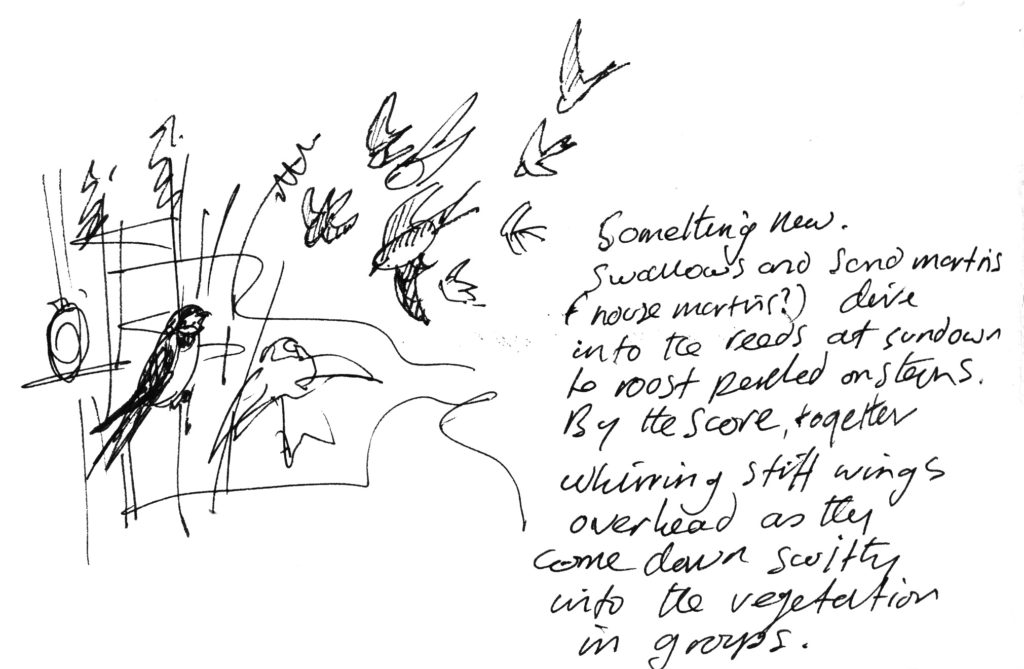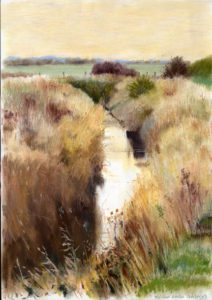Wetlands are one of the few remaining places in the UK where you can still feel a sense of wilderness. Some are managed for the benefit of wildlife, such as Old Hall Marshes in Essex. Each winter flocks of brent geese graze on the meadows, waders probe the mud and skulk in the water margins, and marsh harriers and peregrines hunt the open spaces.
In the autumn of 2007 I was walking back to the car towards dusk, below the sea wall sheltering from the wind. I was aware of a whooshing and flapping sound, then another and another, like a fleet of paper jet fighters flying past my ears just missing my head.
I wasn’t wrong, really. I stopped to see what was happening and quickly realised that large numbers of swallows and martins were flying down into the reed bed to my left, perching up two or three birds to a stem, bending them over, chattering quietly.
This delightful discovery was new to me, and I wondered if the coming migration back to Africa was partly the reason for the large mixed gathering or whether it happens during the summer also. This safety in numbers is possibly a subject for a new painting, similar to the “owl over the A13” project.

A couple of years earlier I made a coloured conte drawing in the studio of a water filled ditch below the sea wall. When you approach secret places such as this you never know what rare bird or animal may come briefly into view, before your clumsy presence disturbs, and it hides in the undergrowth, dives into the water or flies away.

These places are tiny strips of wilderness in an otherwise managed environment.
Old Hall Marshes, conte on paper 2003. Always the chance of seeing a fleeting glimpse of a rare bird or animal, before your presence is feltRecently I took oils and a canvas to a spot where the raised sea wall turns at right angles around the estuary and set up preparing to produce a quick painting at dusk, hopefully with some golden glow in the West setting off the reed heads and twiggy growth in silhouette against the evening sky. I couldn’t find the right viewpoint so aware time was short, I turned away to the East and focused my attention on another ditch similar to the drawing I had made years previously. The bushes seemed to frame the reeds and water quite nicely although it was getting dark rapidly. Three birdwatchers passed by with their tripods and telescopes walking along the sea wall until they seemed to melt into the dusk in front of the town lights, now twinkling in the distance on the far side of the estuary.

I decide to finish as it’s just too dark to mix any paint, and I rely on what I know I’ve mixed on the palette to make a few finishing dabs of light, and scratch through with a palette knife here and there for lighter twigs and grass stems. This is where habitually setting out your paints in the same place and in the same order helps, so you know where each colour is in situations like this! I made a scan of this canvas using photoshop to desaturate and darken it slightly, and enhance the effect of the lights from the town.

The result gives a better impression of the light levels at the time, but would have been quite a challenge to render on site.
It was a long walk back to the car, with all my gear over my shoulder in a holdall and carrying a wet canvas in one hand, along the top of the sea wall, the wet mud of the estuary just catching the remaining light.